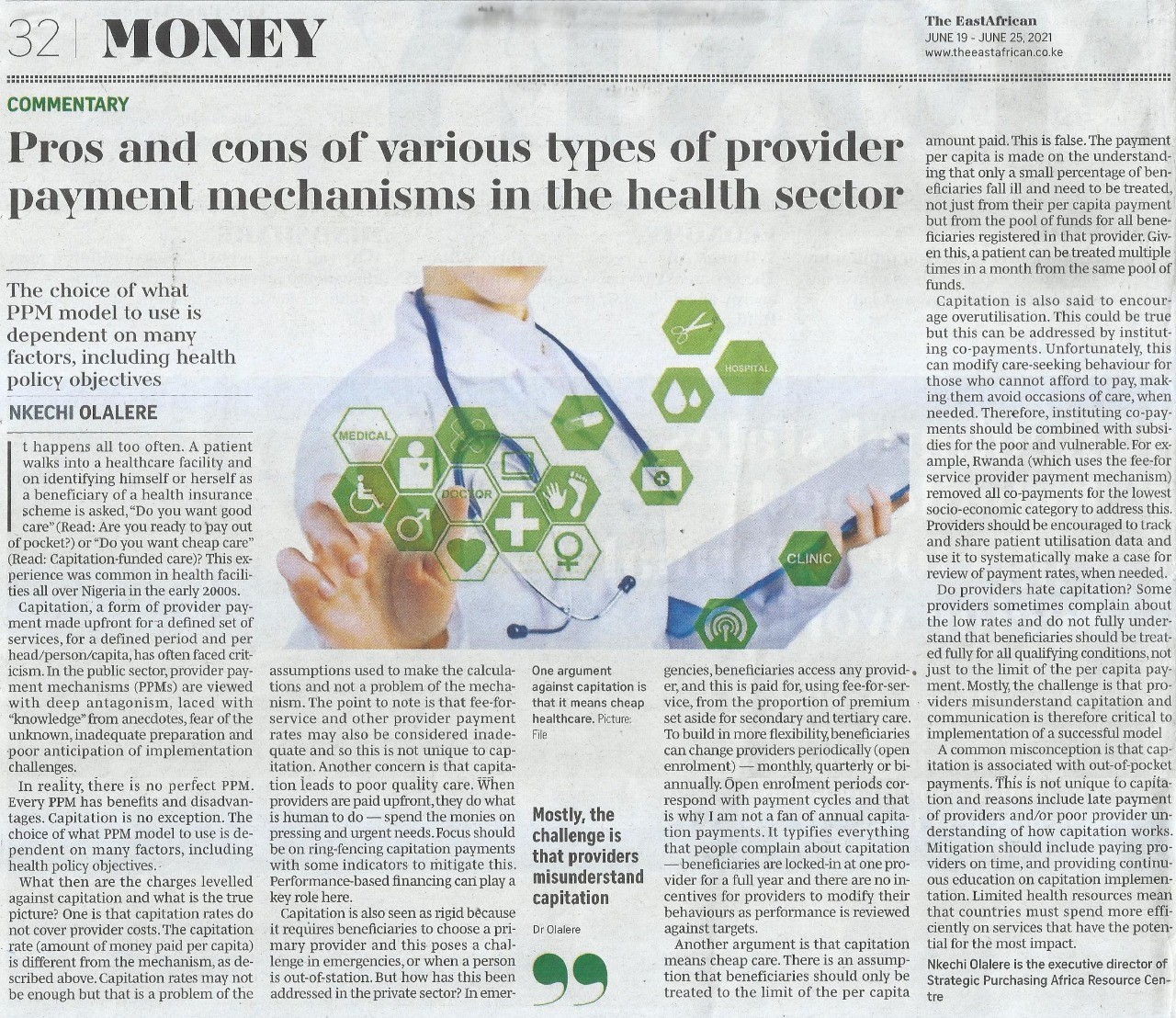By Dr. Nkechi Olalere
It happens all too often. A patient walks into a health care facility and on identifying himself as a beneficiary of a health insurance scheme is asked, ‘do you want good care (read: are you ready to pay out of pocket?), or do you want cheap care (read: capitation-funded care)?’ This experience was commonplace in health facilities all over Nigeria in the early 2000s and makes the assertion that something must be wrong with capitation.
Capitation is a form of provider payment made upfront, for a defined set of services, for a defined period and per head/person/capita; thus, the name, capitation.
The focus of this article is to demystify capitation and how it can be used in the implementation and promotion of primary healthcare (PHC) in the region.
Capitation has often faced criticism, with a litany of reasons. As a public health physician experienced in the implementation of different provider payment mechanisms (PPMs) in the private sector, I was shocked by the abject distrust of capitation I encountered in the public sector. It was viewed with deep antagonism, laced with ‘knowledge’ from anecdotes, fear of the unknown, inadequate preparation and poor anticipation of implementation challenges.
In reality, there is is no perfect PPM. Every PPM has benefits and disadvantages. Capitation is no exception. The choice of what PPM model to use is dependent on many factors, including health policy objectives.
What then are the charges levelled against capitation and what is the true picture? One is that that Capitation rates do not cover provider costs. The capitation rate (amount of money paid per capita) is different from the mechanism, as described above. Capitation rates may not be enough but that is a problem of the assumptions used to make the calculations and not a problem of the mechanism. The point to note is that fee-for-service and other provider payment rates may also be considered inadequate and so this is not unique to capitation.
Another concern is that Capitation leads to poor quality care. This is the loudest argument against capitation. When providers are paid upfront, they do what is human to do – spend the monies on pressing and urgent needs. Focus should be on ring-fencing capitation payments with some indicators to mitigate this. Performance-based financing can play a key role here.
Capitation is also seen as rigid because it requires beneficiaries to choose a primary provider and this poses a challenge in emergencies, or when a person is out-of-station.But how has this been addressed in the private sector? In emergencies, beneficiaries access any provider, and this is paid for, using fee-for-service, from the proportion of premium set aside for secondary and tertiary care. To build in more flexibility, beneficiaries can change providers periodically (open enrolment) – monthly, quarterly or biannually. Open enrolment periods correspond with payment cycles and that is why I am not a fan of annual capitation payments. It typifies everything that people complain about capitation – beneficiaries are locked-in at one provider for a full year and there are no incentives for providers to modify their behaviours as performance is reviewed against targets.
Another argument is that Capitation means cheap care. There is an assumption that beneficiaries should only be treated to the limit of the per capita amount paid. This is false. The payment per capita is made on the understanding that only a small percentage of beneficiaries fall ill and need to be treated, not just from their per capita payment but from the pool of funds for all beneficiaries registered in that provider. Given this, a patient can be treated multiple times in a month from the same pool of funds.
Capitation is also said to encourage overutilization. This could be true but this can be addressed by instituting co-payments. Unfortunately, this can modify care-seeking behaviour for those who cannot afford to pay, making them avoid occasions of care, when needed. Therefore, instituting co-payments should be combined with subsidies for the poor and vulnerable. For example, Rwanda (which uses the fee-for service provider payment mechanism) removed all co-payments for the lowest socio-economic category to address this. Providers should be encouraged to track and share patient utilization data and use it to systematically make a case for review of payment rates, when needed.
Do providers hate capitation? Some providers sometimes complain about the low rates and do notfully understand that beneficiaries should be treated fully for all qualifying conditions, not just to the limit of the per capita payment. Mostly, the challenge is that providers misunderstand capitation and communication is therefore critical to implementation of a successful model
Nigeria has good examples of private providers who embraced capitation because the benefits were communicated, and they experienced them – large pool of enrolees, better cashflow and ability to attract more beneficiaries, if good quality service is provided.
A common misconception is that capitation is associated with out-of-pocket payments. This is not unique to capitation and reasons include late payment of providers and/or poor provider understanding of how capitation works. Mitigation should include paying providers on time, and providing continuous education on capitation implementation.
Beneficiaries should also be educated on grievance resolution like calling the contact centre of the provider, at the time of being asked to pay out-of-pocket, or making formal reports thereafter.
Limited health resources mean that countries must spend more efficiently on services that have the potential for the most impact, like PHC. Capitation helps to strengthen PHC systems, empowering providers to improve the management of resources at the local level.
However, capitation is not a magic bullet. It has benefits and demerits. Most times when capitation is said to have failed, it is because implementation challenges like those addressed in this article, have not been anticipated and mitigated.
The writer is the Executive Director of Strategic Purchasing Africa Resource Center (SPARC)
(This article was first published on 10th June 2021 in The East African)

